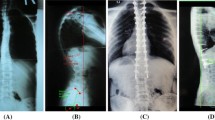Abstract
Purpose
Scheuermann kyphosis is the most common structural kyphosis among adolescence and young people. Surgical treatment may be performed through combined anterior and posterior or posterior-only approaches; to our knowledge, the efficacy of posterior-only approach as less invasive procedure is not well studied in case of severe rigid Scheuermann kyphosis.
Materials and methods
Eighteen patients with severe rigid Scheuermann kyphosis operated through only posterior approach from 2013 to 2016 were evaluated. All information regarding demographic data, curve size before and after the surgery, surgical time, amount of blood loss, correction loss during follow-up and also complications was collected.
Result
There were six females and 12 males. Mean age of the patients was 22.4 years (range 17–38). Mean kyphosis angle before surgery was 87.2° (range 85–105), and that reduced to 47.4° (range 45–55) after the surgery. Mean curve size in hyperextension view was 73.8°. Mean postoperative Cobb angle was 50–55 percent of preoperative curves. Mean hospital admission duration was 3.5 days after the index surgery (range 3–5 days). Mean blood loss during the surgery was 250 ml. Mean surgical duration time was 150 min. Mean follow-up period was 9 months (range 8–48 months). No complication was found among the patients.
Conclusion
Posterior-only approach using advanced osteotomy techniques and posterior release is a safe and reliable approach for treatment of patients suffering from severe rigid Scheuermann kyphosis and provides acceptable deformity correction.

Similar content being viewed by others
References
Scheuermann H (1920) Kyfosis dorsalis juvenilis. Ugesk Leager 82:385393
Scheuermann HW (1921) Kyphosis dorsalis juvenilis. Orthop Chir 41:305–317
Trotta A, Corrado A, Soragnese MF, Santoro N, Cantatore FP (2008) Adult scheuermann’s disease as cause of mechanic dorsalgia [Italian]. Reumatismo 60(1):14–21
Bick EM, Copel JW (1951) The ring apophysis of the human vertebra: contribution to human osteogeny. II. J Bone Joint Surg Am 33(3):783–787
Damborg F, Engell V, Andersen M, Kyvik KO, Thomsen K (2006) Prevalence, concordance, and heritability of scheuermann kyphosis based on a study of twins. J Bone Joint Surg Am 88(10):2133
Sorensen K (1964) Scheuermann’s Juvenile Kyphosis: clinical appearances, radiography, aetiology and prognosis. Copenhagen, Munksgaard
Tribus CB (1998) Scheuermann’s kyphosis in adolescents and adults: diagnosis and management. J Am Acad Orthop Surg 6(1):36–43
Sturm PF, Dobson JC, Armstrong GW (1993) The surgical management of scheuermann’s disease. Spine 18(6):685–691 (Phila Pa 1976)
Bradford DS, Moe JH, Montalvo FJ, Winter RB (1975) Scheuermann’s kyphosis. Results of surgical treatment by posterior spine arthrodesis in twenty-two patients. J Bone Joint Surg Am 57(4):439–448
Bradford DS, Ahmed KB, Moe JH, Winter RB, Lonstein JE (1980) The surgical management of patients with scheuermann’s disease: a review of twenty-four cases managed by combined anterior and posterior spine fusion. J Bone Joint Surg Am 62(5):705–712
Bradford DS et al (1975) Scheuermann’s kyphosis. Results of surgical treatment by posterior spine arthrodesis in twenty-two patients. J Bone Joint Surg Am 57(4):439–448
Lee SS, Lenke LG, Kuklo TR, Valenté L, Bridwell KH, Sides B, Blanke KM (2006) Comparison of scheuermann kyphosis correction by posterior-only thoracic pedicle screw fixation versus combined anterior/posterior fusion. Spine 31(20):2316–2321
Tomé-Bermejo F, Tsirikos AI (2012) Current concepts on scheuermann kyphosis: clinical presentation, diagnosis and controversies around treatment. Revista Española de Cirugía Ortopédica y Traumatología (English Edition) 56(6):491–505
Wood KB, Melikian R, Villamil F (2012) Adult scheuermann kyphosis: evaluation, management, and new developments. J Am Acad Orthop Surg 20(2):113–121
Temponi EF, de Macedo RD, Pedrosa LO, Fontes BP (2011) Scheuermann’s kyphosis: comparison between the posterior approach associated with Smith-Petersen osteotomy and combined anterior-posterior fusion. Revista Brasileira de Ortopedia (English Edition) 46(6):709–717
Yun C, Shen CL (2017) Anterior release for scheuermann’s disease: a systematic literature review and meta-analysis. Eur Spine J 26(3):921–927
Koller H, Juliane Z, Umstaetter M, Meier O, Schmidt R, Hitzl W (2014) Surgical treatment of scheuermann’s kyphosis using a combined antero-posterior strategy and pedicle screw constructs: efficacy, radiographic and clinical outcomes in 111 cases. Eur Spine J 23(1):180–191
Behrbalk E, Uri O, Parks RM, Grevitt MP, Rickert M, Boszczyk BM (2014) Posterior-only correction of scheuermann kyphosis using pedicle screws: economical optimization through screw density reduction. Eur Spine J 23(10):2203–2210
Author information
Authors and Affiliations
Corresponding author
Ethics declarations
Conflict of interest
The authors declare that they have no conflict of interest.
Ethical standards
All procedures performed in studies involving human participants were in accordance with the ethical standards of the institutional and/or national research committee and with the 1964 Helsinki Declaration and its later amendments or comparable ethical standards.
Informed consent
Informed consent was obtained from all individual participants included in the study.
Rights and permissions
About this article
Cite this article
Mirzashahi, B., Chehrassan, M., Arfa, A. et al. Severe rigid Scheuermann kyphosis in adult patients; correction with posterior-only approach. Musculoskelet Surg 102, 257–260 (2018). https://doi.org/10.1007/s12306-017-0526-4
Received:
Accepted:
Published:
Issue Date:
DOI: https://doi.org/10.1007/s12306-017-0526-4




